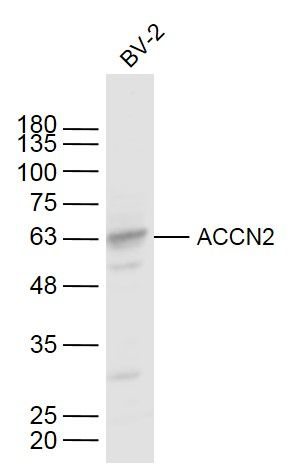产品货号 : mlR12128
英文名称 : ACCN2
中文名称 : 脑钠通道蛋白2抗体
别 名 : ASIC1; Acid sensing ion channel 1; Acid sensing ion channel 1a protein; Acid sensing ion channel; Acid-sensing ion channel 1; AI843610; ASIC1_HUMAN; Acid-sensing ion channel 1; Amiloride-sensitive cation channel 2, neuronal; Brain sodium channel 2; BNaC2; BNAC2.
研究领域 : 神经生物学 通道蛋白 细胞膜受体
抗体来源 : Rabbit
克隆类型 : Polyclonal
交叉反应 : Human, Mouse, Rat, Chicken, Dog, Pig, Cow, Horse, Rabbit, Sheep,
产品应用 : WB=1:500-2000 ELISA=1:500-1000
not yet tested in other applications.
optimal dilutions/concentrations should be determined by the end user.
分 子 量 : 60kDa
细胞定位 : 细胞膜
性 状 : Lyophilized or Liquid
浓 度 : 1mg/ml
免 疫 原 : KLH conjugated synthetic peptide derived from human ACCN2/ASIC1:332-460/528 <Extracellular>
亚 型 : IgG
纯化方法 : affinity purified by Protein A
储 存 液 : 0.01M TBS(pH7.4) with 1% BSA, 0.03% Proclin300 and 50% Glycerol.
保存条件 : Store at -20 °C for one year. Avoid repeated freeze/thaw cycles. The lyophilized antibody is stable at room temperature for at least one month and for greater than a year when kept at -20°C. When reconstituted in sterile pH 7.4 0.01M PBS or diluent of antibody the antibody is stable for at least two weeks at 2-4 °C.
PubMed : PubMed
产品介绍 : Acid sensing ion channel ASIC1 is present in brain as a 4.3-kb transcript with localization to rat dorsal root ganglia. In situ hybridization of rat brain suggests that ASIC1 is most abundant in the main olfactory bulb, cerebral cortex, hippocampal formation, habenula, basolateral amygdaloid nuclei and cerebellum. ASIC1 and H+-gated currents may contribute to the development of fear and anxiety. ASIC2, also designated amiloride-sensitive cation channel 1, neuronal (ACCN1), mammalian degenerin, BNAC1 (MDEG) and brain Na+ channel 1, mediates the normal detection of light touch. ASIC2 mRNA is abundant in brain, specifically in neurons. ASIC2 is expressed as 2.7- and 3.7-kb transcripts in brain and spinal cord tissues. ASIC3, also designated SLNAC1 and TNaC1, mediates detection of lasting pH changes and is involved in modulating moderate- to high-intensity pain sensation. ASIC4, also designated ACCN4 and BNAC4, is abundant in pituitary gland and is also present in the inner ear.
Function:
Cation channel with high affinity for sodium, which is gated by extracellular protons and inhibited by the diuretic amiloride. Also permeable for Ca(2+), Li(+) and K(+). Generates a biphasic current with a fast inactivating and a slow sustained phase. Mediates glutamate-independent Ca(2+) entry into neurons upon acidosis. This Ca(2+) overloading is toxic for cortical neurons and may be in part responsible for ischemic brain injury. Heteromeric channel assembly seems to modulate channel properties. Functions as a postsynaptic proton receptor that influences intracellular Ca(2+) concentration and calmodulin-dependent protein kinase II phosphorylation and thereby the density of dendritic spines. Modulates activity in the circuits underlying innate fear.
Subunit:
Homotrimer or heterotrimer with other ASIC proteins. Interacts with STOM and ASIC2. Interacts with PRKCABP.
Subcellular Location:
Cell membrane. Localizes in synaptosomes at dendritic synapses of neurons. Colocalizes with DLG4.
Tissue Specificity:
Expressed in most or all neurons.
Post-translational modifications:
Phosphorylation by PKA regulates interaction with PRKCABP and subcellular location. Phosphorylation by PKC may regulate the channel.
Similarity:
Belongs to the amiloride-sensitive sodium channel (TC 1.A.6) family.
ACCN2 subfamily.
SWISS:
P78348
Gene ID:
41
Important Note:
This product as supplied is intended for research use only, not for use in human, therapeutic or diagnostic applications.
产品图片












